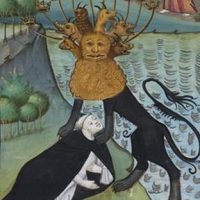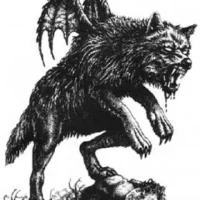Kludde : The Shapeshifting Demon
Listen
At a glance
| Description | |
|---|---|
| Origin | Germanic Mythology |
| Classification | Hybrids |
| Family Members | N/A |
| Region | Netherlands, Belgium, Germany |
| Associated With | Shapeshifting |
Kludde
Introduction
The Kludde is one of the most unsettling figures in Germanic and Dutch folklore, particularly feared in the rural landscapes of Flanders, Brabant, and parts of northern Germany. Often described as a shapeshifting demon or malevolent water spirit, Kludde embodies the deep fears of travelers who once braved forests, rivers, and lonely paths at night. Legends about this terrifying entity flourished during the Middle Ages, when belief in witches, demons, and restless spirits shaped everyday life. More than a simple bogeyman, Kludde represents the chaos of untamed nature, the dangers of isolation, and the possibility of encountering forces beyond human comprehension.
Its stories were often told as cautionary tales, warning children and adults alike to stay close to home after nightfall. Unlike some benevolent household spirits of European folklore, Kludde was never protective. Instead, it was purely destructive, a symbol of the unpredictable horrors that could strike from the darkness.
Physical Traits
The defining characteristic of Kludde is its ability to shapeshift, making it a truly elusive predator. Accounts describe the creature transforming into animals such as a black dog, a cat, a frog, a bat, or a bird of ill omen. One of its most frightening forms is that of a half-starved horse, which tricks victims into climbing onto its back before galloping at breakneck speed into rivers or marshes, attempting to drown its rider.
In some Flemish tales, Kludde manifests as a small sapling that suddenly grows into an immense tree, its branches blotting out the sky and disorienting travelers below. Another chilling marker of its presence is the appearance of blue flames, which either float before it or glow like eyes in the night. The clinking of heavy chains, often draped around its neck or legs, is another signal that Kludde is near.
When it takes its canine form, Kludde is especially fearsome, sometimes walking on its hind legs and leaping at the throats of its victims. Even when assuming different guises, common features remain: grotesque proportions, unnatural movements, and a sinister aura that leaves no doubt about its otherworldly nature. These traits made Kludde both terrifying and impossible to predict, ensuring its place in the nightmares of rural Europe.
Family
Unlike gods, giants, or fairies with complex genealogies, Kludde is a solitary demon. Folklore does not tie it to a family or pantheon; instead, it exists as a wandering, destructive force. Some local traditions link Kludde to the souls of witches or the restless dead, suggesting that it may have been born from dark sorcery or unholy curses. In these versions, the Kludde becomes a form of punishment or transformation, a cursed existence without peace or kinship.
Comparisons can be drawn with other European entities such as the Hedley Kow of England or the Nachtkrapp from German lore, both shapeshifters known for terrifying people with their tricks. However, Kludde remains unique in its cruelty, with no redeeming qualities or protective instincts. Its isolation reinforces its role as an outsider spirit, untethered to divine hierarchies or natural orders, and purely focused on terror.
Other names
Kludde appears under different names across Belgium and the Netherlands, reflecting its widespread and fluid identity. Variants such as Kleure, Klerre, Kledde, and Waterkledde appear in local traditions, each emphasizing a different aspect of the creature. The name Waterkledde, for instance, highlights its connection to rivers, lakes, and marshes—common sites of its attacks.
In coastal towns like Ostend, Kludde is sometimes equated with nixies or water sprites, blending its demonic features with local water spirit lore. Other accounts describe it as Kludde-Lodder, a name linking it to Lodder, a Dutch watersprite. The word “Kludde” itself is thought to stem from the creature’s habit of crying out its name—“Kludde! Kludde!”—as it stalks or ambushes its prey.
The diversity of names shows how the figure of Kludde absorbed elements from different traditions, making it both a universal shapeshifter and a uniquely Flemish demon.
Powers and Abilities
Kludde is most notorious for its shapeshifting, allowing it to take the form of almost anything—animal, human, or even an inanimate object like a tree. Its transformations are often used to deceive and ensnare victims, luring them into danger before revealing its true nature.
Its arsenal of supernatural abilities is vast. Kludde is described as possessing immense speed and strength, able to outrun any traveler and become impossibly heavy when leaping onto someone’s back. In many stories, the creature is linked to water, either dragging victims into rivers or appearing suddenly at bridges and lakesides.
Another of its traits is auditory manipulation. The rattling of its chains, the sudden cry of “Kludde!”, or even the mimicry of human voices are used to terrify or lure the unwary. In some accounts, it can even sing hypnotic songs that cause disorientation.
Eyewitness descriptions often highlight its ability to vanish instantly, reinforcing its identity as a spectral being. Some stories also claim it can induce blindness, confusion, or madness in those it targets. Despite its fearsome powers, Kludde shares a vulnerability common to many demonic figures: it recoils from daylight, church bells, and religious symbols, which can drive it away or banish it entirely.
Modern Day Influence
Though the name Kludde may not be widely recognized outside Belgium and the Netherlands, the demon’s legend continues to echo in modern times. In rural communities, tales of Kludde are still told to warn children against wandering near forests or waterways after dark. These stories preserve a cultural memory of how folklore once served both as entertainment and as a protective teaching tool.
Kludde’s legacy has also found a place in literature, music, and visual art. A Belgian black/sludge metal band named Kludde has drawn inspiration from the legend, incorporating its dark themes into music that resonates with mythological and occult imagery. Folklore enthusiasts, writers, and digital artists have revived interest in the creature, using its eerie form as a symbol of shapeshifting, deception, and primal fear.
In academic and cultural settings, Kludde is often cited as an example of the European shapeshifter archetype, alongside werewolves, kelpies, and black dogs. Online communities and folklore archives have expanded its reach, introducing the demon to new audiences fascinated by cryptids and supernatural lore. Its influence can even be traced into fantasy role-playing games and horror fiction, where elements of Kludde’s story—blue flames, chain-rattling specters, demonic horses—resurface in new guises.
By embodying the terrifying uncertainties of the night, Kludde remains relevant not only as a folkloric relic but also as a cultural symbol. It bridges the gap between medieval superstition and contemporary fascination with the uncanny, ensuring that its name still lingers in the shadows of European mythology.
Related Images
Source
“Kludde.” (n.d.) Myth and Folklore Wiki – Fandom. https://mythus.fandom.com/wiki/Kludde
“Kludde.” (2019, June 6). A Book of Creatures. https://abookofcreatures.com/2019/06/07/kludde/
“The Shapeshifting Demon in Germanic and Dutch Folklore.” (2024, June 14). Horror Chronicles. https://horrorchronicles.com/the-kludde/
“Kludde.” (n.d.) Pantheon: Encyclopedia Mythica. https://pantheon.org/articles/k/kludde.html
“The Kludde: The Demon Dog of Belgium.” (n.d.) Facts-Chology. https://factschology.com/mmm-podcast-articles/kludde-demon-dog-belgium
“Kludde.” (n.d.) Monstropedia. https://www.monstropedia.org/index.php?title=Kludde
Northern Mythology: Comprising the Principal Popular Traditions and Superstitions of Scandinavia, North Germany, and The Netherlands. Volume 3. (2014). [Google Books] https://books.google.com/books/about/Northern_Mythology.html?id=GWFBAQAAMAAJ
Lumley, E. (1852). The Fairy Mythology: Illustrative of the Romance and Superstition of Various Countries. London: H. G. Bohn.
Frequently Asked Questions
What is lorem Ipsum?
I am text block. Click edit button to change this text. Lorem ipsum dolor sit amet, consectetur adipiscing elit. Ut elit tellus, luctus nec ullamcorper mattis, pulvinar dapibus leo.
What is lorem Ipsum?
I am text block. Click edit button to change this text. Lorem ipsum dolor sit amet, consectetur adipiscing elit. Ut elit tellus, luctus nec ullamcorper mattis, pulvinar dapibus leo.
What is lorem Ipsum?
I am text block. Click edit button to change this text. Lorem ipsum dolor sit amet, consectetur adipiscing elit. Ut elit tellus, luctus nec ullamcorper mattis, pulvinar dapibus leo.
What is lorem Ipsum?
I am text block. Click edit button to change this text. Lorem ipsum dolor sit amet, consectetur adipiscing elit. Ut elit tellus, luctus nec ullamcorper mattis, pulvinar dapibus leo.
What is lorem Ipsum?
I am text block. Click edit button to change this text. Lorem ipsum dolor sit amet, consectetur adipiscing elit. Ut elit tellus, luctus nec ullamcorper mattis, pulvinar dapibus leo.








